I. Introduction
A brief overview of the construction industry and its importance
The construction industry is a vital sector of the global economy, responsible for the design, construction, and maintenance of the built environment. This includes everything from homes and offices to bridges, roads, and infrastructure. The industry plays a crucial role in the development and growth of society, providing the infrastructure and buildings that support our daily lives.
The construction industry is one of the largest employers in the world, providing jobs for millions of people. It is also a major contributor to economic growth, as construction projects generate significant investments and provide a boost to the local economy. Construction projects also stimulate other industries, such as manufacturing, transportation, and services.
In addition to its economic importance, the construction industry is also essential for improving the quality of life. Construction projects, such as hospitals, schools, and affordable housing, are essential for meeting the basic needs of society. Furthermore, well-designed and constructed buildings and infrastructure can improve the health, safety, and overall well-being of people.
However, the construction industry is also one of the most resource-intensive industries, with a significant impact on the environment and society. Therefore, it is increasingly important for the construction industry to adopt sustainable business models that minimize negative impacts and maximize positive contributions. This includes reducing the environmental footprint of the industry, improving energy efficiency, and promoting the use of sustainable materials and technologies.
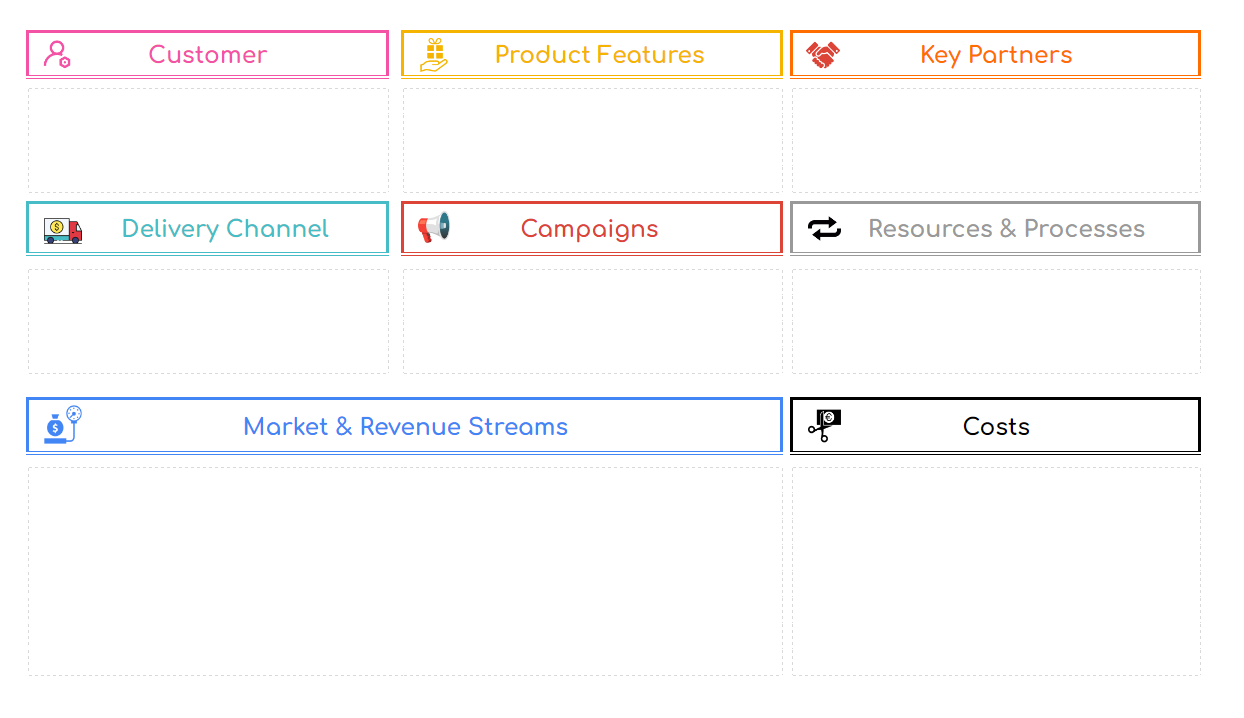
Image: Business Model Canvas for construction business on EpiProdux.com
The need for a robust and sustainable business model innovation
As the construction industry continues to evolve, the need for robust and sustainable business model innovation becomes increasingly important. A robust business model is one that is well-suited to the needs of the project, the owner, and the industry and can withstand changing market conditions. A sustainable business model is one that minimizes negative impacts on the environment and society while maximizing positive contributions.
Business model innovation in the construction industry can take many forms, including new ways of financing, designing, building, and operating construction projects. For example, new technologies such as Building Information Modeling (BIM), cloud-based project management tools, and data analytics are changing the way construction projects are managed and are leading to a new generation of technology-driven business models. These technologies can lead to improved efficiency, reduced costs, and faster completion times.
Another example of business model innovation is the adoption of sustainable business models such as Integrated Project Delivery (IPD) and Green Building. These models focus on reducing the environmental footprint of the industry while also improving social and economic outcomes.
A robust and sustainable business model is essential for the long-term success of the construction industry. It allows the industry to respond to changing market conditions, to meet the needs of the project, the owner, and the industry, and to minimize negative impacts on the environment and society.
You can read more here about the construction business models in this library, with 200 different business models for construction companies’ products.
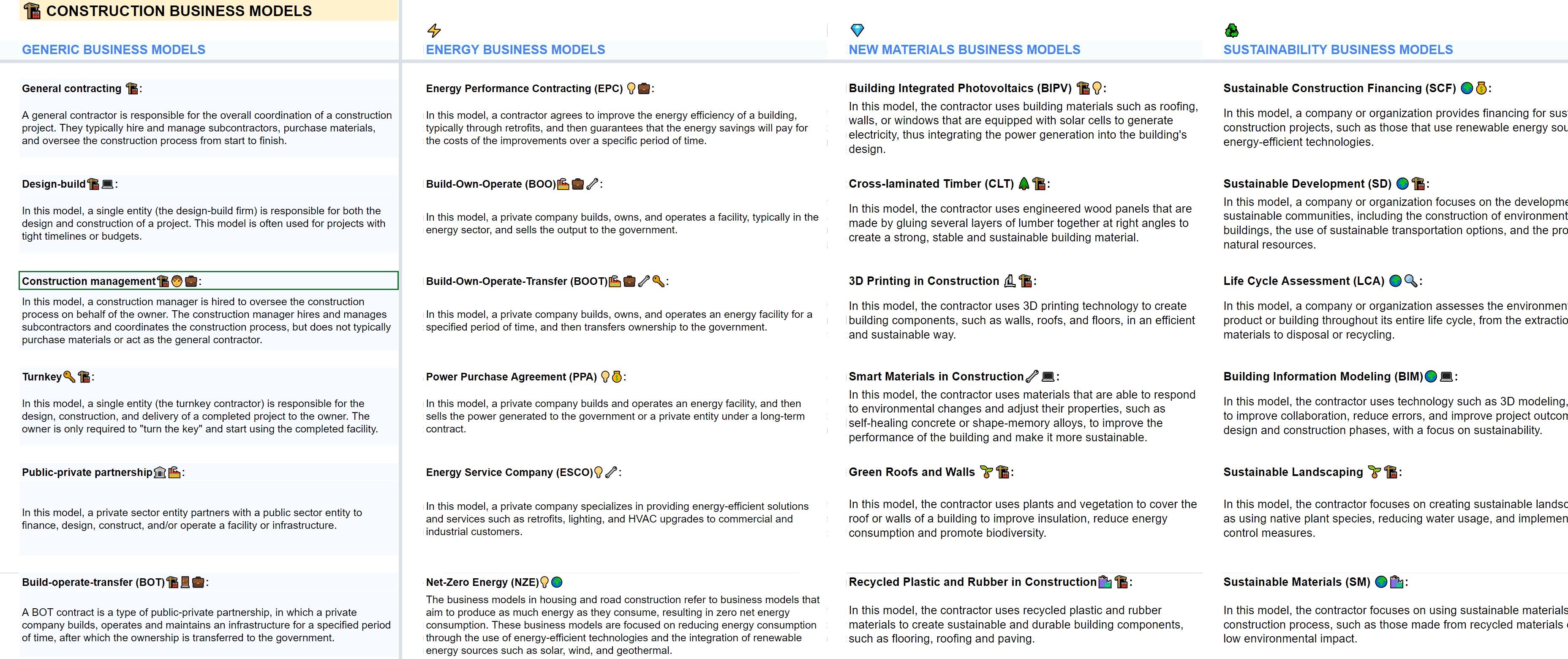
Image: Construction Business Model Library with 200 + examples generated on EpiProdux.com
II. Traditional design-bid-build model
Explanation of how the model works
The traditional design-bid-build model is the most widely used business model in the construction industry. Under this model, the owner of a construction project hires an architect or engineer to design the project and then solicits bids from construction companies to build it. The company that submits the lowest bid is awarded the contract. This model is straightforward and easy to understand, but it can also be time-consuming and expensive.
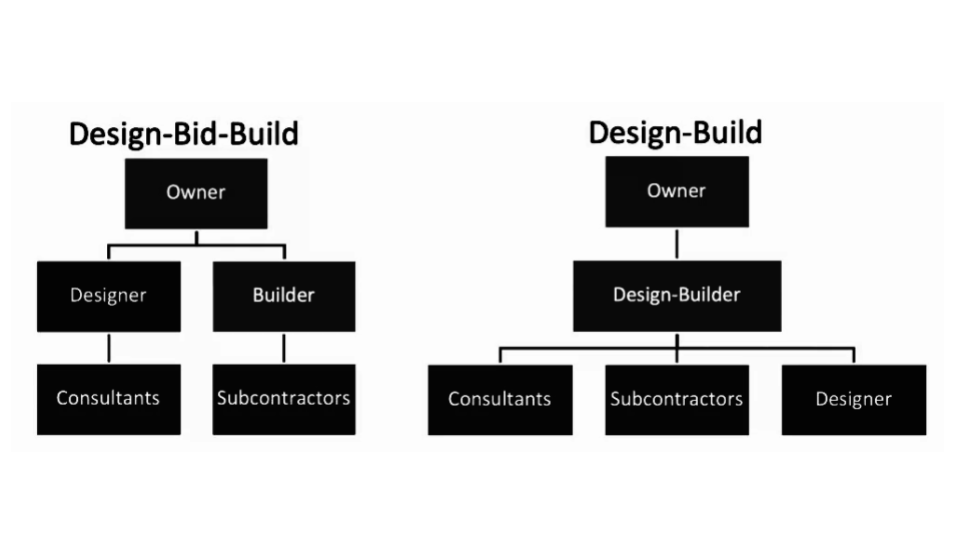
Image: Design-bid-build business model vs Design-Build Business Model in Construction
The design-bid-build process typically begins with the owner hiring an architect or engineer to design the project. The design team creates detailed plans and specifications, which are then used to solicit bids from construction companies. The construction companies review the plans and specifications and submit a bid, which includes a detailed estimate of the cost of the project and a proposed schedule for completion. The owner then selects the company with the lowest bid to build the project.
Pros and cons of the model
One of the main advantages of the traditional design-bid-build model is that it is easy to understand and implement. The process is straightforward and the roles and responsibilities of each party are clearly defined. This can make it easier for the owner to manage the project and for the construction company to estimate costs and schedule the work.
However, the traditional design-bid-build model also has some significant drawbacks. One of the main disadvantages is that it can be time-consuming and expensive. The process of designing and soliciting bids can take several months, and the cost of hiring an architect or engineer can be significant. In addition, the pressure to keep costs low can lead to corners being cut or inferior materials being used.
Another drawback is that the design-bid-build model can be less transparent and less competitive. Since the owner is not involved in the design and construction process, they may not have a clear understanding of the project’s progress or the quality of the work being done. Additionally, the process of soliciting bids from multiple companies can be less competitive than a single company doing the design and construction.
III. Design-build model
Explanation of how the model works
The design-build model is a popular alternative to the traditional design-bid-build model in the construction industry. Under this model, the owner hires a single company to design and build the project, which simplifies the process and reduces costs. This model is particularly well-suited to smaller projects and can be more efficient, but it can also be less transparent and less competitive.
The design-build process begins with the owner hiring a single company to design and build the project. The company is responsible for both the design and construction phases of the project, which eliminates the need for the owner to hire separate design and construction teams. This can save time and money, as the design and construction teams are able to work together more efficiently.
Pros and cons of the model
One of the main advantages of the design-build model is that it is more efficient than the traditional design-bid-build model. The design and construction teams work together from the start of the project, which can reduce the time it takes to complete the project and minimize delays caused by miscommunication or misunderstandings. Additionally, the owner only has to deal with one company, which can simplify the process and reduce costs.
However, the design-build model also has some disadvantages. One of the main drawbacks is that it can be less transparent and less competitive. Since the owner is only dealing with one company, they may not have a clear understanding of the project’s progress or the quality of the work being done. Additionally, the process of awarding the contract to a single company can be less competitive than soliciting bids from multiple companies.
Another disadvantage of the design-build model is that it can be risky for the owner. Since the owner is relying on a single company to design and build the project, if that company is unable to complete the project, the owner may be left with a partially completed project and no other options. Additionally, if the company goes bankrupt or otherwise fails to complete the project, the owner may be left with a significant financial loss.
IV. Construction management model
Explanation of how the model works
The construction management model is a widely used business model in the construction industry. Under this model, the owner hires a construction manager to oversee the project, who then hires subcontractors to perform the work. This model can be more flexible than the traditional design-bid-build model and allows for more input from the owner, but it also carries more risk for the owner as they are responsible for managing the subcontractors.
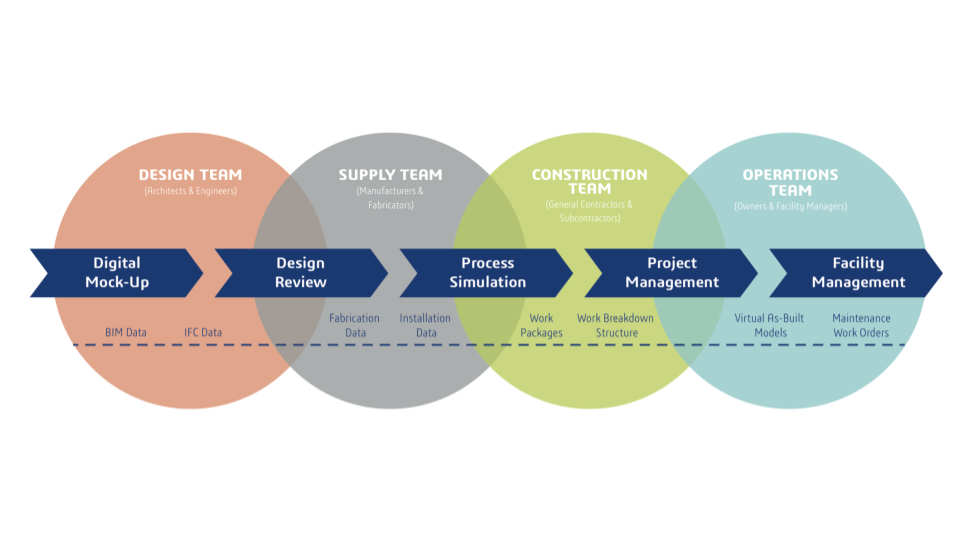
Image: Dassault Systems approach to Construction Management
The construction management process begins with the owner hiring a construction manager to oversee the project. The construction manager is responsible for managing the project from start to finish, including the hiring of subcontractors to perform the work. The owner is responsible for providing the construction manager with the necessary funding and resources to complete the project.
Pros and cons of the model
One of the main advantages of the construction management model is that it is more flexible than the traditional design-bid-build model. The construction manager can work with the owner to create a customized plan that meets the owner’s specific needs and budget. Additionally, the construction manager can be more involved in the design and construction process, which can lead to better quality and more cost-effective projects.
However, the construction management model also has some drawbacks. One of the main disadvantages is that it carries more risk for the owner. Since the owner is responsible for managing the subcontractors, they may be held liable if the subcontractors fail to complete the work properly or on time. Additionally, since the owner is responsible for providing the necessary funding and resources, they may be left with a partially completed project if funding runs out.
Another disadvantage of the construction management model is that it can be less transparent and less competitive. Since the owner is not involved in the design and construction process, they may not have a clear understanding of the project’s progress or the quality of the work being done. Additionally, the process of hiring subcontractors can be less competitive than soliciting bids from multiple companies.
V. Public-Private Partnership (PPP) model
Explanation of how the model works
The Public-Private Partnership (PPP) model is becoming increasingly popular in the construction industry as a way to finance, design, build and operate large, complex infrastructure projects. In this model, the public sector partners with the private sector to share the risks and rewards of a project. This model can provide significant benefits such as reduced costs, improved efficiency and better alignment of incentives between the public and private sectors.
The PPP process typically begins with the public sector identifying a need for a new infrastructure project, such as a new highway, hospital or school. They then invite private sector companies to submit proposals for designing, building, financing, and operating the project. The private sector company that is awarded the contract is responsible for designing, building, and operating the project, while the public sector provides the funding.
Pros and cons of the model
One of the main advantages of the PPP model is that it can reduce costs for the public sector. The private sector is typically able to design, build, and operate the project more efficiently and at a lower cost than the public sector. This is because private sector companies are typically more efficient and have more experience in managing large construction projects.
Another advantage of the PPP model is that it can improve efficiency. Since the private sector is responsible for designing, building, and operating the project, they have a strong incentive to complete the project on time and within budget. Additionally, the private sector is typically able to bring new technologies and innovations to the project, which can lead to improved quality and cost savings.
A key advantage of the PPP model is that it aligns the incentives of the public and private sectors. The private sector is typically only paid once the project is completed and is generating revenue, which means they have a strong incentive to complete the project on time and within budget. Additionally, the private sector is typically responsible for maintaining and operating the project for a specified period, which means they have a long-term incentive to ensure the project is of high quality.
However, PPP projects can also have some drawbacks. One of the main disadvantages is that it can be complex and time-consuming to set up and manage. Additionally, since the private sector is responsible for designing, building and operating the project, the public sector may not have as much control over the project, which can lead to a lack of transparency. Additionally, the private sector may not always put the public’s interest first, and the contract may not always be in the public’s best interest.
Another potential challenge with PPP projects is the allocation of risks and responsibilities between the public and private partners. PPP projects often involve a transfer of risks from the public sector to the private sector. However, the allocation of risks and responsibilities should be carefully considered and balanced, as both parties have different capabilities, interests, and objectives.
Additionally, PPP projects require a significant amount of legal and financial expertise to set up and manage. The public sector may lack the necessary resources and expertise, which can lead to delays and increased costs. Furthermore, PPP projects often require a significant amount of upfront financing, which can be a challenge for some private sector companies.
Examples of successful PPP projects in the construction industry
There are many examples of successful Public-Private Partnership (PPP) projects in the construction industry around the world. Some notable examples include:
The Chicago Skyway Toll Bridge: This project involved the renovation and operation of a toll bridge in Chicago, Illinois, USA. The private sector partner, Skyway Concession Company, financed, designed, built, and operated the bridge for 99 years under a lease agreement with the City of Chicago. The project was completed on time and within budget, and it has become a model for other PPP projects around the world.

The Sydney Harbour Tunnel: This project involved the design, construction, and operation of a tunnel under Sydney Harbour in Australia. The private sector partner, Sydney Harbour Tunnel Company, financed, designed, built, and operated the tunnel for 99 years under a lease agreement with the government of New South Wales. The project was completed on time and within budget, and it has significantly improved transportation in Sydney.

The London Underground Public-Private Partnership (PPP): This project involved the upgrade and maintenance of the London Underground rail system in the UK. The private sector partners, Metronet and Tube Lines, financed, designed, built, and maintained the rail system for 30 years under a contract with Transport for London. The project was completed on time and within budget, and it has led to significant improvements in the reliability and safety of the London Underground.
The M6 Toll Road: This project involved the design, construction, and operation of a toll road in the UK. The private sector partner, Midland Expressway Limited, financed, designed, built, and operated the toll road for 30 years under a concession agreement with the government of the UK. The project was completed on time and within budget, and it has significantly improved transportation in the region.
The Golden Ears Bridge: This project involved the design, construction, and operation of a bridge in British Columbia, Canada. The private sector partner, Golden Crossing General Partnership, financed, designed, built, and operated the bridge for 30 years under a concession agreement with the government of British Columbia. The project was completed on time and within budget, and it has significantly improved transportation in the region.
VI. Technology-Driven models
Explanation of how technology is changing the construction business models
The construction industry is currently undergoing a technological revolution, with new technologies such as Building Information Modeling (BIM), cloud-based project management tools and data analytics being adopted at an unprecedented rate. These technologies are changing the way construction projects are managed and are leading to a new generation of technology-driven business models.

Image: Construction managers collect construction data in real-time for a instant reporting
The adoption of new technologies such as BIM, cloud-based project management tools and data analytics
Building Information Modeling (BIM) is a digital representation of a building or infrastructure project. It allows architects, engineers and construction professionals to work together in a virtual environment, creating a detailed and accurate model of the project.
BIM enables better collaboration, coordination, and communication throughout the construction process, which can lead to improved quality, reduced costs and faster completion times.
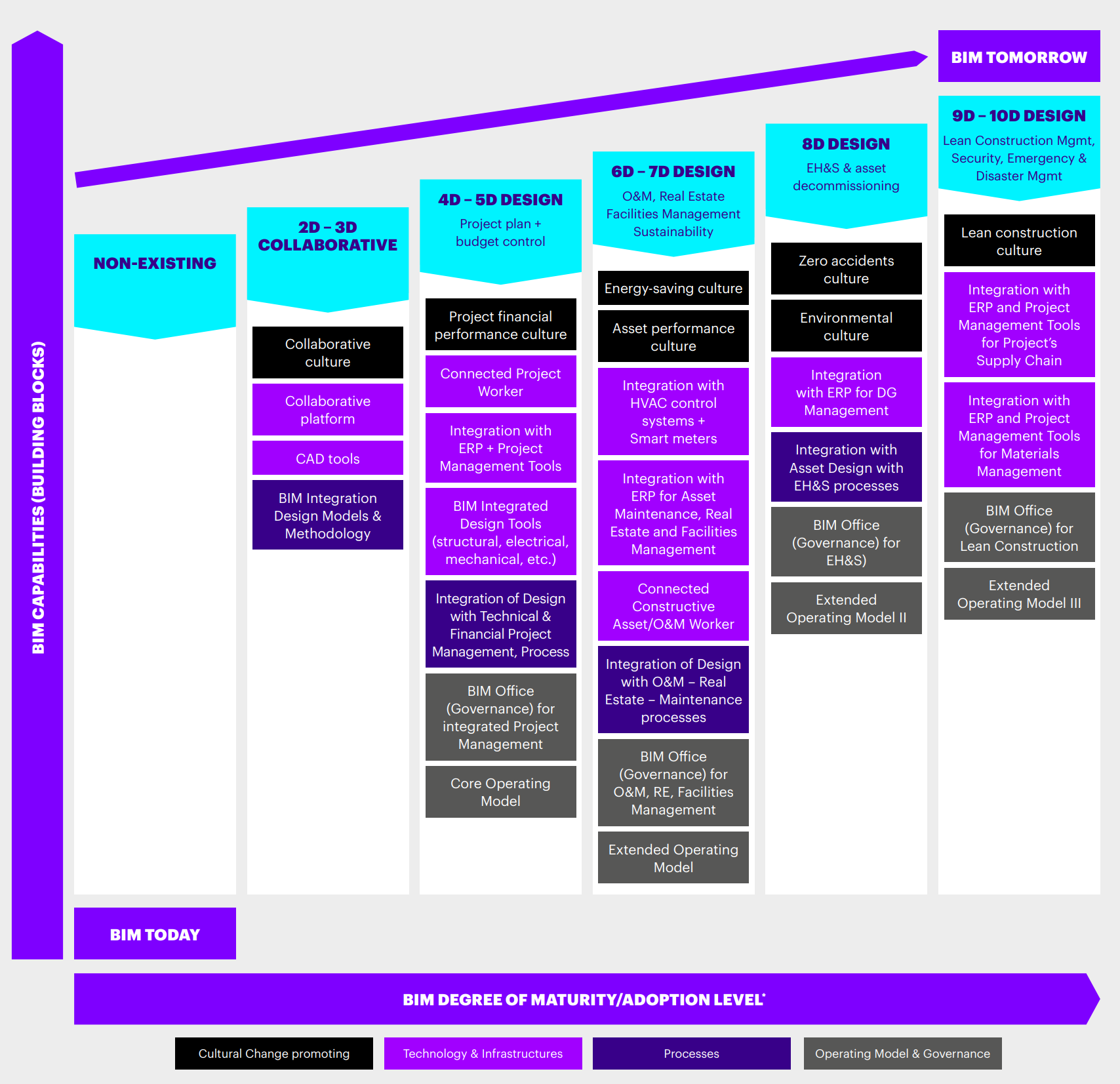
Image: 10D Building Information Modeling (BIM) from Accenture
Cloud-based project management tools are also becoming increasingly popular in the construction industry. These tools allow construction professionals to access project information from anywhere, at any time, using any device. They enable real-time collaboration and communication, as well as providing an easy way to store and share project information. This can lead to improved efficiency, reduced costs and faster completion times.
Data analytics is also changing the way construction projects are managed. With the growing amount of data generated by construction projects, data analytics enables construction professionals to make better-informed decisions by providing insights into the performance of the project. This can lead to improved quality, reduced costs, and faster completion times.
EpiProdux is a business model software that can help construction businesses to create more innovative business models and make more profit by providing them with the tools and resources they need to optimize their operations, reduce costs, and improve efficiency
The impact of technology on the industry’s efficiency, productivity, and cost savings
Technology-driven business models in construction are more efficient and cost-effective, as they allow for better collaboration, coordination, and communication. They also enable construction professionals to make better-informed decisions and to improve the overall performance of the project.
However, there are also some challenges associated with technology-driven business models in construction. One of the main challenges is the lack of expertise and skills needed to implement these technologies. Construction professionals need to be trained to use these technologies, which can be time-consuming and expensive. Additionally, the cost of these technologies can be high, which may be a barrier for some companies.
In conclusion, the construction industry is currently undergoing a technological revolution, with new technologies such as Building Information Modeling (BIM), cloud-based project management tools, and data analytics being adopted at an unprecedented rate. These technologies are changing the way construction projects are managed and are leading to a new generation of technology-driven business models. They are more efficient and cost-effective, as they allow for better collaboration, coordination, and communication. However, there are also some challenges associated with technology-driven business models in construction such as lack of expertise and skills, and high costs of technology. Despite these challenges, technology-driven business models in construction are becoming increasingly important and are the future of the industry.
VII. Conclusion
The importance of choosing the right model for a specific project and the needs of the owner
It is important to note that choosing the right business model for a construction project is crucial for the success of the project. Each business model has its own advantages and disadvantages, and the best model for a specific project will depend on the project’s size, complexity, and the needs of the owner.
For example, the traditional design-bid-build model is well-suited for small-scale projects where the design is well-defined and the owner is not looking for significant input or flexibility. However, for larger, more complex projects, the design-build or construction management model may be more appropriate. These models allow for more input and flexibility from the owner, and they can lead to more efficient and cost-effective projects.
Similarly, the Public-Private Partnership (PPP) model may be suitable for large, complex infrastructure projects, such as transportation, energy, and water supply. However, it may not be as effective for smaller or less complex projects.
The key to success in choosing the right business model for a construction project is to conduct a thorough evaluation of the project’s needs and the owner’s requirements. This includes an analysis of the project’s size, complexity, budget, and schedule, as well as the owner’s goals and objectives.
It is also important to consider the owner’s level of expertise and experience in construction. For example, if the owner is new to the construction industry, they may want to consider a more traditional model, such as the design-bid-build model, as it is easier to understand and manage. However, if the owner has experience in construction and wants more input and flexibility, a design-build or construction management model may be more appropriate.
In conclusion, choosing the right business model for a construction project is crucial for the success of the project. Each business model has its own advantages and disadvantages, and the best model for a specific project will depend on the project’s size, complexity, and the needs of the owner. It’s important to conduct a thorough evaluation of the project’s needs and the owner’s requirements before deciding on the right business model.
The importance of the construction industry and the need for sustainable business models.
The construction industry plays a vital role in the development and growth of society by providing the infrastructure and buildings that support our daily lives. However, it is also one of the most resource-intensive industries, with a significant impact on the environment and society. Therefore, it is increasingly important for the construction industry to adopt sustainable business models that minimize negative impacts and maximize positive contributions.
Sustainable business models in the construction industry focus on reducing the environmental footprint of the industry, while also improving social and economic outcomes. They aim to minimize the use of resources, reduce waste and pollution, and promote the use of sustainable materials and technologies.
One example of a sustainable business model in the construction industry is the Integrated Project Delivery (IPD) model. This model is based on collaboration, trust, and a shared vision among all stakeholders. It aims to optimize the performance of the project by aligning incentives, reducing waste, and fostering innovation. This model is considered more sustainable as it emphasizes on shared risk and reward, and it encourages collaboration and communication among all stakeholders.
Another example of a sustainable business model is the Green Building model, which promotes the use of sustainable materials and technologies, and aims to reduce the environmental impact of buildings. Green buildings are designed to be energy-efficient, water-efficient, and to have a reduced carbon footprint. This model is considered sustainable as it helps to reduce the environmental impact of buildings and promote energy efficiency and conservation.
In conclusion, the construction industry is essential for the development and growth of society. However, it is also one of the most resource-intensive industries, with a significant impact on the environment and society. Therefore, it is increasingly important for the construction industry to adopt sustainable business models that minimize negative impacts and maximize positive contributions. Examples of sustainable business models include Integrated Project Delivery (IPD) and Green Building. These models focus on reducing the environmental footprint of the industry while also improving social and economic outcomes.
EpiProdux is a business model software designed specifically for the construction industry. It helps construction businesses to create more innovative business models and make more profit by providing them with the tools and resources they need to optimize their operations. The software allows businesses to streamline their processes, improve communication and collaboration among stakeholders, and make data-driven decisions.
Frequently Asked Questions
What are the different types of business models in the construction industry?
The traditional design-bid-build model, the design-build model, the construction management model, and the Public-Private Partnership (PPP) model are some of the main business models used in the construction industry.
What is the traditional design-bid-build model?
The traditional design-bid-build model is the most widely used business model in the construction industry. Under this model, the owner hires an architect or engineer to design the project and then solicits bids from construction companies to build it. The company that submits the lowest bid is awarded the contract.
What is the design-build model?
The design-build model is an alternative to the traditional design-bid-build model. Under this model, the owner hires a single company to design and build the project, which simplifies the process and reduces costs.
What is the construction management model?
The construction management model involves the owner hiring a construction manager to oversee the project, who then hires subcontractors to perform the work. This model can be more flexible than the traditional design-bid-build model and allows for more input from the owner, but it also carries more risk for the owner as they are responsible for managing the subcontractors.
What is the Public-Private Partnership (PPP) model?
The Public-Private Partnership (PPP) model is becoming increasingly popular in the construction industry as a way to finance, design, build, and operate large, complex infrastructure projects. In this model, the public sector partners with the private sector to design, build, and operate a project.
What are the advantages and disadvantages of each business model?
Each business model has its own advantages and disadvantages, and the best model for a specific project will depend on the project’s size, complexity, and the needs of the owner. The traditional design-bid-build model is straightforward and easy to understand, but it can also be time-consuming and expensive. The design-build model is more efficient, but it can also be less transparent and less competitive. The construction management model allows for more input and flexibility from the owner, but it also carries more risk. The Public-Private Partnership (PPP) model can be a viable option for certain types of projects, but it is important for the public sector to carefully evaluate whether it is the right fit for their specific project and needs.
Can you provide examples of successful Public-Private Partnership (PPP) projects in the construction industry?
Some notable examples include The Chicago Skyway Toll Bridge, The Sydney Harbour Tunnel, The London Underground Public-Private Partnership (PPP), The M6 Toll Road, and The Golden Ears Bridge.
What is the role of technology in construction business models?
The construction industry is currently undergoing a technological revolution, with new technologies such as Building Information Modeling (BIM), cloud-based project management tools, and data analytics being adopted at an unprecedented rate. These technologies are changing the way construction projects are managed and are leading to a new generation of technology-driven business models.
Why is it important to choose the right business model for a construction project?
Choosing the right business model for a construction project is crucial for the success of the project. Each business model has its own advantages and disadvantages, and the best model for a specific project will depend on the project’s size, complexity, and the needs of the owner. A thorough evaluation of the project’s needs and the owner’s requirements is necessary in order to select the most appropriate model. Failure to choose the right business model can lead to project delays, cost overruns and failure to meet the needs of the project and the owner.
How can business model innovation contribute to the sustainability of the construction industry?
Business model innovation can take many forms, including new ways of financing, designing, building, and operating construction projects. Adopting sustainable business models such as Integrated Project Delivery (IPD) and Green Building can minimize negative impacts on the environment and society while maximizing positive contributions. This includes reducing the environmental footprint of the industry, improving energy efficiency, and promoting the use of sustainable materials and technologies.


